We were recently approached by a young boy who wanted to make a difference in the lives of homeless pets. This impressive young man, age eleven, has created a Facebook page to help us bring attention to wonderful local shelter pets in need of good homes. In his first interview, William interviews Stanley, a 1 year old pit mix who is available for adoption at the San Jose Animal Care Center. Below is my interview with Stanley! He was such a sweet and amazing dog. My brother Jacob and I both got to play with him today. Stanley was so excited to get outside and play, but he was also very well behaved! He didn’t knock my little brother over once and was pretty gentle around him. Stanley loves to chase after anything you throw for him. He also likes to get belly rubs and give ear kisses. I think Stanley would make a great family dog. He needs someone to adopt him right away! 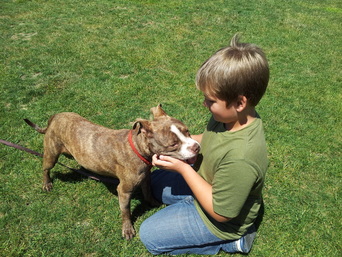 William: What kind of dog are you, Stanley?
Stanley: Hi, William so nice to meet you. I'm a Pit Bull Terrier mix.
William: How old are you?
Stanley: I am a year old and all grown up now.
William: I have heard that Pit Bull's are dangerous, are you dangerous?
Stanley: Absolutely not. I am friendly and sweet. I know there is a lot of publicity about bad Pit Bulls but really the problem is the people who train them to be aggressive. All dogs at the San Jose shelter are behaviorally tested to be sure that we are nice and friendly.
William: Do you get along well with other dogs? How about cats?
Stanley: At the shelter I sometimes get to be in playgroups with other dogs and we have such a good time. I love small dogs and nice, friendly bigger dogs. We romp around and really enjoy each other. The shelter doesn't test us with cats so it's unknown but probably a "feline free" home is best for me.
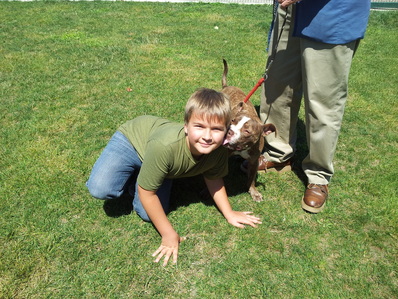 William: Do you like kids?
Stanley: Yes, I am a people kind of canine. I love people. I love to play and I love to cuddle. I would be happy in a home with children. We could play and have so much fun.
William: What brings you to the shelter?
Stanley: I was found as a stray which means I was wandering on the streets and someone brought me into the shelter; so not much is known about my background. And I'm not talking....
William: What is it like living at the shelter?
Stanley: Well, it's not bad because the people are very nice and it's safe. I get fed and I get to go for walks. But most of the day I spend in my kennel and it's pretty small. I know I would be soooo much happier in a home with people who will take good care of me and give me love.
William: How much would it cost to become your new owner?
Stanley: The adoption fee at the shelter is normally $115. My fee is only $25 because I've been at the shelter for a while. After I get adopted, I will need some things like a bed, food bowls, leash/collar and toys because I love toys. But it shouldn't be too much. My food shouldn't cost too much either.
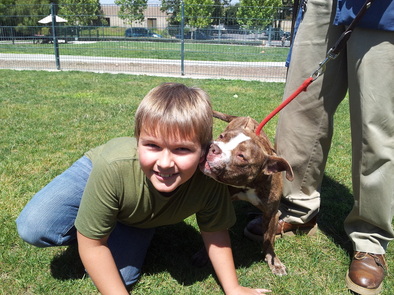 William: What is your favorite thing to eat?
Stanley: I can't tell you because at the shelter we get fed Science Diet food and I don't get to choose.
William: What is your idea of a perfect Saturday?
Stanley: I would love to go for a walk, maybe a run, then settle down for some good nap time. I like to be with people so having my family around on Saturday would be great. Or maybe I could go on errands with my family (as long as I don't have to stay in the hot car). Just hanging out next to my family would be fun too. I really am open to lots of things and would be happy to do just about anything. For me, it's all about being with my family.
William: What are you looking for in an owner?
Stanley: Well, I really want a family to love me and give me a nice, safe place to live. I hope that I don't have to be alone all the time because I love being with people. I really want to be in the house with my family most of the time. Having a yard would be nice too so that we can play together. I want my family to be nice and to want to teach me things so that I can learn how to behave well. It would be great to have my owner hug and cuddle with me so I know that I am loved.
Stanley was excited to get outside and play, but he was also very well behaved! He didn’t knock my little brother over once (who is 6) and was gentle around him. Stanley loves to chase after anything you throw for him. He also likes to get belly rubs and give ear kisses. I think Stanley would make a great family dog and I hope that someone is able to give him the home he deserves.
-William Hatch
 Saved from shelter at 2 weeks old This blog post was contributed by: Melissa Lisbon, Co-Founder of San Jose Animal AdvocatesWhen two neighbors and I founded San Jose Animal Advocates almost 2.5 years ago, we were motivated to help educate the community about all extensive animal welfare resources available to us in the greater San Jose area. Many people don't realize that the City of San Jose Animal Care Center is one of the largest municipal shelters in the state of California, that we have nationally renown LEED (Leadership in Energy and Environmental Design) certified humane society as well as a wildlife center serving our community (not to mention many other animal welfare organizations). After joining the Advisory Committee of the San Jose Animal Care Center over 2 years ago, I wanted San Jose Animal Advocates to help support the shelter in the three areas they needed the most help: under aged kittens, overpopulation of chihuahuas and community outreach about shelter services and adoption. This summer we have launched our Save a Kitten 2012 program to help save more under aged kittens in our community.
 Fostered and adopted thru HSSV Save a Kitten 2012 is a community outreach program to recruit new kitten foster parents for the Humane Society Silicon Valley (HSSV). HSSV has a comprehensive program for this short-term (or foster) care providing an orientation class, food, medical care, and surgery dates for the spay/neuter procedure. The typical care commitment is four to eight weeks. Read more about the HSSV foster program. Our goal this summer is to recruit enough new kitten foster parents to save an additional 200 kittens who would normally be humanely euthanized. Personally I don't think our community likes to think about kittens being put to sleep, but it is a reality and the community can help prevent this by participating in our program.
 Fostered and adopted thru program San Jose Animal Advocates is reaching out through our growing social network to promote this program. Through an all volunteer army, we are promoting the program through community events, social media, marketing, local veterinarian offices, community bulletin boards and even have a local library helping us spread the word about Save a Kitten 2012. Part of the program is also spreading the word about low cost spay/neuter resources offered by local vet clinics and offering advice on TNR (trap, neuter, return) for community/feral cats. San Jose Animal Advocates is working to get the word out about this important initiative – with a dedicated Facebook page (http://www.facebook.com/SaveaKitten2012), links to resources, and additional information here: http://www.sjanimaladvocates.org/new-save-a-kitten-2012.html. Fostering kittens is a very rewarding and educational experience, but may not work for everyone. In addition to volunteering with San Jose Animal Advocates and spreading the word about the program, the Humane Society Silicon Valley is also seeking donations of the following items which go directly to their foster care program for kittens: - Canned Wellness cat food in chicken flavor
- Royal Canin Baby Cat or Kitten dry food
- Small ceramic cat dishes
- Non-clumping kitty litter
- New litter boxes
Items can be dropped off anytime in their donation bins at 901 Ames Avenue in Milpitas.
| San Jose Animal Advocates is a community group of volunteers whose mission is to raise awareness of the homeless pet population in San Jose. We believe that the community has the power and the desire to improve the lives of homeless pets, and Save a Kitten 2012 is one way in which we all can make a difference.
| |
 Hi! My name is Spencer, ID#A781099 Look at this face!!! Spencer is 2 years old and LOVES people and dogs. He is getting very stressed at the shelter and is not doing well there. He has until Monday June 18th to find a home.Please go meet this wonderful dog today! He is at the San Jose Animal Care Center. Ask to meet Spencer - you won't be sorry! For more information about Spencer read his page here.
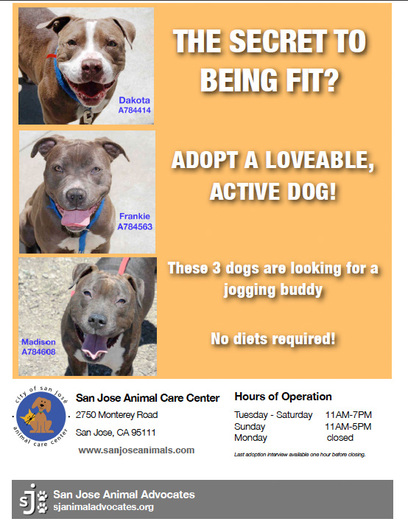 Ok - it is now officially the season to get get active and fit!
These three wonderful dogs are waiting to be adopted at the San Jose Animal Care Center and will become your own personal trainer :) Hikes, runs, long walks, beach combing, they will help you fit into that swimsuit in no time. Plus, you will receive unconditional love, snuggles, endless tail wagging AND you save a life!
Please help us spread the word about these loveable dogs! They have been waiting at the shelter too long, and the shelter, the volunteers and all of us at San Jose Animal Advocates want to find them good homes!! Click on the links below to learn more about each one of these special girls! Please go to the shelter TODAY and meet your new best friend. Dakota
Frankie
Madison
 UPDATE: Bosco was rescued and is living a wonderful life in San Francisco! Here is a recent photo of him taken by his talented mom. We wish you well Bosco - you deserve it!
I have always respected Muttville Senior Dog Rescue. These special folks, led by Sherri Franklin, save senior dogs from shelters all over the Bay Area. They know how special these senior dogs are, and how they make the perfect companion for many folks who are looking for a more mellow friend. Unfortunately, we don't have a local cat rescue group which focuses on senior cats. Senior cats present a particularly difficult problem especially during kitten season when adult cats are overlooked for kittens at our shelters. Ironically, cats typically live longer lives than dogs, yet few people want to give a senior cat a chance. Like senior dogs, senior cats provide gentle, low key companionship. Their active days are behind them, but they are wiser, and have so much love to give.
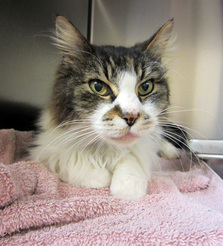
Meet Bosco. The shelter thinks this guy is about 15 years old, but he certainly doesn't look it. Bosco was turned in to the shelter after being found roaming the neighborhood. He had been someone's cat, but they had left the neighborhood and didn't bother taking him with them so Bosco had to fend for himself.
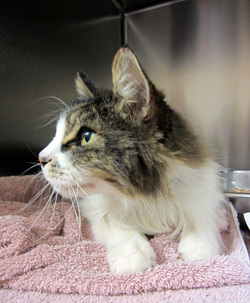 When I met Bosco yesterday at the shelter, he was calm and grateful to be petted. He immediately starting to make biscuits with his massive paws, and strangely seemed relieved to be in the shelter. Unfortunately, what he doesn't know is that he has very little time to stay there before he will be euthanized if he doesn't get rescued. The good news is that we do have a rescue group who is willing to pull this sweet old man, but we need a foster home or a permanent home for him.Did you know that cats can live into their 20s? By the looks of Bosco, he has a lot of living left. His one wish? A home that commits to him for life and won't leave without him again. He's ready for his new chapter, can you help him find his special person?Contact us if you can help Bosco!
This blog post is contributed by Michelle Williams, a San Jose Animal Advocates volunteer.
Every single day, things happen that affect the way we think, the way we behave, the way we feel… and most of the time, we are hardly aware. If you ask me when animal welfare became personal, I can tell you exactly when that happened.
The date was May 15, 2010 – this is the story of my “turning point”.
It was 10am on a Saturday morning and my husband came into the house muttering something about kittens in the backyard. This wasn’t your typical Saturday conversation over coffee. We have no pets, and there was certainly no reason why there should be newborn kittens behind our air conditioning unit.
I knew I had to do something and since the feral cat population is a sore subject for my husband, I also knew that would not include bringing them into our home. After placing an ad on Craigslist, I realized that I may be attracting the wrong kind of attention. So, I looked up information for a *local shelter, went and found a box and a soft fuzzy blanket. Let me just mention – for such little creatures, those little teeth were sharp!
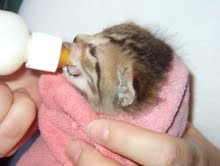 Several days later, I called the shelter to enquire about trapping feral cats and asked how the kittens were doing. I was told they were euthanized… I was beyond heartbroken. The reality of the situation was that the kittens were unable to eat on their own and would have required around the clock care. At that weight, the kittens needed a foster “meowmie” to bottle feed and teach the kittens how to eliminate. The weeks that followed continued to break my heart over and over as the momma cat repeatedly came into my back yard looking for her kittens. At one point, she brought another cat with her as if to say “I swear I left them here! Please help me find them!” Once I let myself off the hook, I decided to try and make a difference. Every shout begins with a voice. This is mine. Adopt. Foster. Spay. Neuter. * prewean kittens that are brought to our area shelters are typically euthanized. If the mother is still around, the best thing you can do is leave the kittens with their mother until they are old enough to eat on their own. There are wonderful resources such as Itty Bitty Orphan Kitty (IBOK Rescue's) Prewean packet (free at all Bay area shelters and Pet Food Express stores) and video. These resources can help you care for the prewean kittens until they are old enough to eat on their own, and then able to be adopted into a permanent home. Monthly classes on how to care for prewean kittens will be given at Humane Society Silicon Valley, and they are always looking for kitten foster parents. Read about their foster program, and save a kitten, save the world!
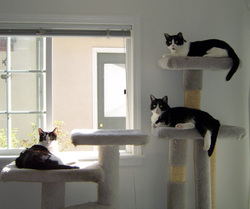 Karen's family _This blog post has been contributed by Karen Zamel, a cat lover and first time attendee of Best Friends National No More Homeless Pet Conference. As an animal lover, I was recently reminded by the brilliant folks from the Best Friends Animal Society in Utah that love alone isn’t enough to provide for our pets. It’s a great place to start, but pet ownership brings with it immense responsibility as well as enormous reward. Animals need much of the same nurturing, care, and protection that many people reserve for, well, other people. It’s an important concept and one my husband and I take seriously…our three rescue cats are our kids. We adopted our first kitten 14 years ago – she had been abandoned at my mom’s vet. My husband and I were both new to cat ownership, but we promised the vet that “Mopps” would only be an indoor-only cat. Period. "Gates" and "Stray Cat," our two other rescues, are also indoor-only cats, too. We found some great vets and cat sitters, learned as much as we could, and have protected our cats from the stresses of kitchen remodeling, a few lengthy vacations, a couple of potentially serious illnesses, various teeth extractions, and the trials and tribulations of finding the right food, cat litter, scratching posts and toys. In return, we are so fortunate that the three feline members of our family -- all between 14-1/2 and 12-1/2 years old -- are healthy and happy. Each day, I am grateful for the company, comfort, love, and fun they provide us. They have changed our lives for the better, and I will ardently argue with anyone who asserts that cats are nonchalant, aloof, or disinterested in the TLC of a good owner. I would also like to apologize to my mother-in-law for sharing with our cats, the blanket she gave us for Christmas. This is the same blanket she said was too expensive for them, but they love it as much as we do, and are only laying on it, I promise. I would also like to share these essential pet care tips provided by our friends at Best Friends… - License your pet and provide permanent ID.
- Spay and neuter your pets.
- Provide training, physical care, socialization, and attention their entire lives.
- Don’t allow pets to become a nuisance or threat to the community.
- Procure your pets only from a responsible and ethical source.
These tips -- along with a lot of love -- can change the lives of pet owners and their pets!
Tis the season for lots of food, family and potential for some mishaps with our canine family members. Lisa Perrault, certified dog trainer and behaviorist provides us with some great pointers to make our holiday season happy for all 2 legged and 4 legged family and friends!  Grover, tempted by cookies _Company, Cookies and Canines
Holidays transform many of us into seasonal entertainers. This time of year, we put a lot of demands on ourselves to cook stunning meals, decorate our homes, and shop for perfect gifts. We also expect our dogs to channel their inner Emily Post and transform into gracious hosts and hostesses.
Not all of our canines are naturally well-mannered entertainers. Your dog may feel that Aunt Millie’s newly knitted scarf is a perfect tug toy and the gingerbread cooling on the counter is a delicious mid-morning snack. Most dogs are not Santa Claus believers, so we need other strategies to convince Rover to be on his best behavior. Training good manners is possible at any age, but it takes time and a bit of practice to learn new skills. Considering all you are juggling right now, here are some time-sensitive suggestions to make sure Rover adds a bit of charm to your holiday celebration.
 Shelby all dressed up for guests Door
Would you like to welcome guests to your home without a barking chorus? Noisy dogs and our shouts of “quiet” start any party off with an unwanted dose of stress. Take the doorbell out of the equation by securing the lock mechanism with duct tape and hanging a “Welcome, Come In” sign on your door.
An open-door policy will minimize barking but you will need to take steps to prevent Rover from charging out of the front door to greet guests and visit neighbors. Instead of trying to do battle at the door, shut off Rover’s access to the front hallway. A walk-through baby gate placed in your front hallway is a perfect option to keep an open flow for humans while preventing Rover from charging through the door. A few brave souls try to jump a gate, so test your setup before the party.
Creating a dog-free zone at your front door has the added advantage of allowing you to control greetings between your dog and guests. The doorway is the most challenging place for shy or overexcited dogs to meet visitors. Barking or jumping can be minimized by moving greetings to a lower stress place in your home. Even a welcoming and well-mannered mutt can not help with guests. Once your company settles in, they can greet your friendly pooch with the attention that she deserves.
 Holiday Cookie Table, photo by Melinda Athey _Food No one wants to spend the party at the emergency vet with a dog who scarfed the baking chocolate or order a pizza after FiFi samples the Christmas ham. Dogs are genetically determined to be on the lookout for food and no other time of year presents a better opportunity for finding forbidden goodies. - Prep time - Save yourself stress by giving Rover something else to do during your cooking marathon. He can keep the kids company in the family room or play with a new toy on his bed. I enjoy the help of my resident crumb cleaners during every-day cooking, but I want all non-essential hands and paws out of the kitchen when cooking for a crowd.
- Hors d’oeuvres - Most of us do not routinely leave plates of special snacks sitting unattended at dog nose level. So it is not surprising when Roxy helps herself to your fancy cheese board in front of company. The beginning of a party is a busy time for the party host so you will not be able to guard against food thieves. Test out your pup before the party by baiting the coffee table with something delicious and surreptitiously monitoring the table from the other room. If Roxy goes for the goods, plan to put party trays on high tables that she cannot reach.
- A sit down meal is often the highlight of a holiday celebration and another busy time for the host. Have a Kong stuffed and ready to give Rover before you sit down to eat to avoid any embarrassment of a begging dog.
- Leftovers - Your company has left and leftover breads and sweets are all over your counter. Pack leftovers away in air-tight/dog proof containers. If Rover often helps himself to midnight snacks off of your counter, consider asking Santa to bring you a breadbox this year.
More Holiday Tips- For large gatherings and for dogs that may be extra sensitive or new to crowds, consider designating a primary dog minder. This is the person to remember to take dog out for potty break and keep an eye to make sure she is not getting overwhelmed or stealing food.
- Dogs are part of our families, but luckily do not have a sentimental attachment to our holidays. If you have a fearful dog, it may be the kindest to keep her confined in a safe zone away from the party chaos.
- If you are going to confine your dog to a new room, do a few test runs before the party to make sure she will be calm and quiet. Set aside special rawhide chews or stuffed Kongs to keep her busy during the party.
- A leash can be helpful tool to manage interactions between dog-shy guests or with a rambunctious dog. A leashed dog is still a part of the party but cannot jump on small kids or steal food.
- Establish a new holiday tradition of a post-meal walk. This is a great way for willing guests to enjoy time with your dog and also helps with digestion.
- Make Roxy a central part of the celebration by dressing her up or showing off tricks to your guests.
Next month we will focus on New Year’s resolutions and National Train Your Dog Month.
 Trixie practicing stay! Contributed by Lisa Perrault of MyWellManneredMutt. Lisa is a professional certified dog trainer and behavorist.Last month, I discussed how physical and mental exercise can help alleviate behavior problems related to boredom when dogs are left alone. This month, I’ll discuss general confidence boosting training exercises that can also help a mildly stressed dog. Please note: If your dog is showing signs of serious separation anxiety, it’s always best to contact a training professional. Your Dog’s “Go To” PlaceOur bedrooms are sanctuaries from the busy world and dogs also deserve a place of their own. This exercise will make your dog’s bed a happy place where they can retreat in times of stress.
 Chloe in bed, looking for positive reinforcement To Teach Go to Place:- Toss a food treat on the bed. Repeat this at least 10 times.
- Once he/she is eagerly running to their bed, add a verbal cue such as “bed.” Point to the bed if your dog doesn’t respond to the word. Reward your dog for walking over to the bed.
- Add a down cue after your dog is standing on their bed. Reward this action as well.
- Soon, he will walk over and lie down on his bed for a single cue. Begin to wait a second or two before giving him the treat.
- Practice sending your dog to bed from different places in your home, including the front door.
 "How long do I need to stay here?" Out of Sight StayStay commands can be paired with the “Go to Place” exercise or done on their own. “Stay” means, “stay in one spot until I come back and release you.” Remember, it isn’t reasonable to ask your dog to stay when you are away from home because she will need to get up and move around during the day. - Begin by teaching your dog to stay when you are in sight.
- If your dog can do a solid stay for 10 seconds with you in front of her, begin to make it harder by walking around the room.
- Always return to your dog to release him from the stay.
- Think about the 3Ds of stay - distance, duration, and distraction. Work on one “D” at a time, gradually increasing the difficulty level of the command.
Distance—How far you are from your dog? Duration —How long you are asking your dog to stay? Distraction —What is going on that might be interesting to your pup? (Including your motions- moving around, touching a food container or picking up a toy.) - After your dog can hold a stay for 30 seconds while you move around the room, you can try your first out of sight stay. Walk out of the room, turn around, and walk right back in.
- Gradually build up the distance you are out of sight.
- Remember, the “Stay” command is hard for dogs! Give them an easy one once and awhile to keep the game fun.
- Out of sight training and a safe place can help dogs that are experiencing mild levels of stress at home. They are also useful training techniques to get our dogs out from underfoot and impress our holiday visitors.
I recently had the pleasure of listening to a Petsmart Charities webinar presented by Amy Shever, Director of 2nd Chance 4 Pets. This non profit organization educates the public about life planning for pets, a topic that is sadly overlooked and results in approximately 500,000 animals being euthanized at area shelters because their owners have passed away or become incapacitated. This statistic is hard to believe given how much we love our pets. 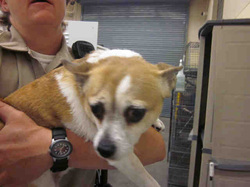 Surrendered to the shelter due to owner's passing
2nd Chance 4 Pets provides very straightforward steps and proper documentation to put in place which will prevent your beloved pet from ending up at the local animal shelter. This topic may seem difficult to think about, but the reality is no one ever knows when something tragic is going to happen to them. It is easier than you think to make arrangements for your pets (just in case). The following information was provided in the recent webinar from 2nd Chance 4 Pets: In the confusion that accompanies a person’s unexpected illness, accident, or death, pets may be overlooked. To prevent this from happening, take these simple precautions:
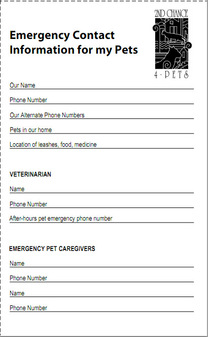 Emergency Card - Identify at least two responsible friends or relatives who agree to provide temporary care if needed. Give them keys to your home, feeding and care instructions, the name of your veterinarian, and information about any permanent care provisions you have made.
- Make sure neighbors, friends, and relatives know how many pets you have, and provide them with contact information for emergency caregivers.
- Carry an “alert identification card” that lists the names and phone numbers of emergency caregivers. Post removable “in case of emergency” notices on your doors or windows, specifying how many and what types of pets you have. (Emergency cards can be downloaded from the 2nd Chance 4 Pets website)
Awareness of this issue is the first step in helping our animal companions and preventing our animals from unnecessary euthanasia as well as providing pet caregivers with peace of mind. 2nd Chance 4 Pets has a wealth of information on their website, with easy downloadable forms to get all in order related to life time planning for your pets. Your pets will thank you!
|























 RSS Feed
RSS Feed